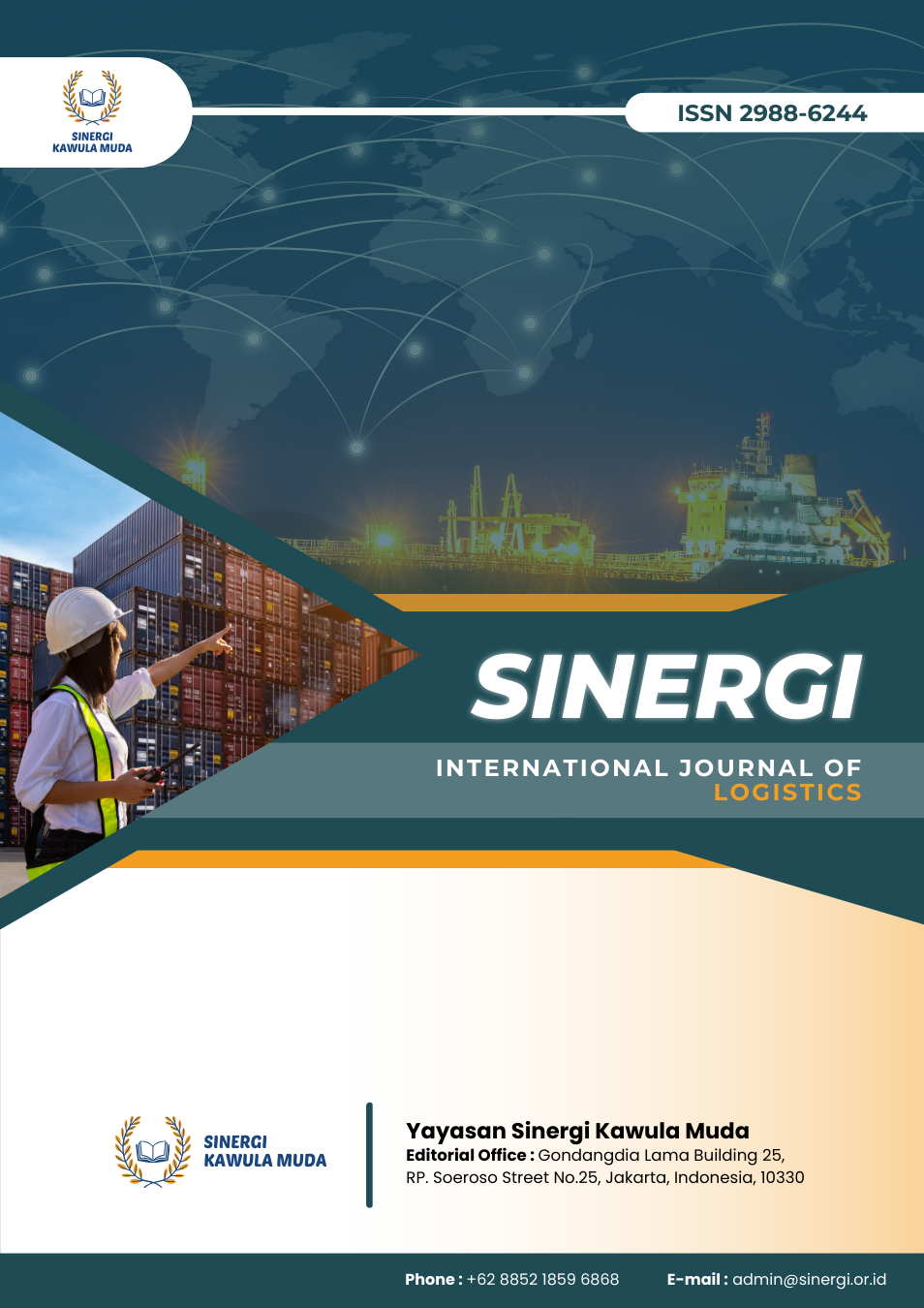Implementation of Cross Docking: Food Aid Distribution Program in Sigi Regency
DOI:
https://doi.org/10.61194/sijl.v3i2.755Keywords:
Cross Docking, Humanitarian Logistics, Food Aid Distribution, Disaster Response, Stunting Prevention, Supply Chain Resilience, Rural InfrastructureAbstract
Stunting remains a persistent public health challenge in disaster prone regions, particularly in Indonesia. This study investigates the implementation of cross docking logistics for the distribution of food aid to at risk households in Sigi Regency, Central Sulawesi. Employing a qualitative case study approach, data were collected through semi structured interviews with 15 logistics personnel and direct field observations. Thematic analysis was used to interpret patterns related to distribution efficiency, coordination, and infrastructure adaptation. The results demonstrate that cross docking significantly reduced distribution time from four to two days, enhanced product quality by minimizing spoilage, and improved logistical responsiveness through specialized transport and local sourcing. Inter agency collaboration and basic digital systems enabled real time data verification and ensured equitable delivery. The study highlights the practicality of cross docking in overcoming infrastructural constraints and maintaining service continuity in post disaster contexts. These findings contribute to the discourse on humanitarian logistics by illustrating the operational and public health benefits of agile distribution methods. The study suggests that cross docking, when combined with adaptive local strategies and digital integration, offers a scalable and resilient model for food aid logistics in disaster prone regions.
References
Adeoya, A. A., Sasaki, H., Fuda, M., Okamoto, T., & Egawa, S. (2022). Child Nutrition in Disaster: A Scoping Review. The Tohoku Journal of Experimental Medicine, 256(2), 103–118. https://doi.org/10.1620/tjem.256.103 DOI: https://doi.org/10.1620/tjem.256.103
Akbar, M. T., Mahardhika, D. W., & Sihaloho, E. D. (2021). Stunting in Eastern Indonesia: Determinants and Solution From Indonesian Family Life Survey. Jurnal Cita Ekonomika, 15(1), 1–13. https://doi.org/10.51125/citaekonomika.v15i1.3230 DOI: https://doi.org/10.51125/citaekonomika.v15i1.3230
Balhara, K. S., Silvestri, D. M., Winders, W. T., Selvam, A., Kivlehan, S. M., Becker, T. K., & Levine, A. C. (2017). Impact of Nutrition Interventions on Pediatric Mortality and Nutrition Outcomes in Humanitarian Emergencies: A Systematic Review. Tropical Medicine & International Health, 22(12), 1464–1492. https://doi.org/10.1111/tmi.12986 DOI: https://doi.org/10.1111/tmi.12986
Barsing, P., Daultani, Y., Vaidya, O. S., & Kumar, S. (2018). Cross-Docking Centre Location in a Supply Chain Network: A Social Network Analysis Approach. Global Business Review, 19(3_suppl), S218–S234. https://doi.org/10.1177/0972150918757847 DOI: https://doi.org/10.1177/0972150918757847
Blankenship, J., Rudert, C., & Aguayo, V. M. (2020). Triple Trouble: Understanding the Burden of Child Undernutrition, Micronutrient Deficiencies, and Overweight in East Asia and the Pacific. Maternal and Child Nutrition, 16(S2). https://doi.org/10.1111/mcn.12950 DOI: https://doi.org/10.1111/mcn.12950
Buijs, P., Danhof, H. W., & Wortmann, J. C. (2016). Just‐in‐Time Retail Distribution: A Systems Perspective on Cross‐Docking. Journal of Business Logistics, 37(3), 213–230. https://doi.org/10.1111/jbl.12135 DOI: https://doi.org/10.1111/jbl.12135
Chapagain, T., & Raizada, M. N. (2017). Impacts of Natural Disasters on Smallholder Farmers: Gaps and Recommendations. Agriculture & Food Security, 6(1). https://doi.org/10.1186/s40066-017-0116-6 DOI: https://doi.org/10.1186/s40066-017-0116-6
Charles, A., Lauras, M., Wassenhove, L. N. V, & Dupont, L. (2016). Designing an Efficient Humanitarian Supply Network. Journal of Operations Management, 47–48(1), 58–70. https://doi.org/10.1016/j.jom.2016.05.012 DOI: https://doi.org/10.1016/j.jom.2016.05.012
Chinogwеnya, K., & Utete, R. (2023). Outsourcing for Emergency Relief: Unravelling Key Strategies. International Journal of Research in Business and Social Science (2147-4478), 12(8), 48–60. https://doi.org/10.20525/ijrbs.v12i8.2913 DOI: https://doi.org/10.20525/ijrbs.v12i8.2913
Cozzolino, A. (2021). Platforms Enhancing the Engagement of the Private Sector in Humanitarian Relief Operations. Sustainability, 13(6), 3024. https://doi.org/10.3390/su13063024 DOI: https://doi.org/10.3390/su13063024
Dudukalov, E., Subhani, M. I., & Ushakov, D. (2020). Cross Docking as a Factor of Distribution Efficiencies Improving in Conditions of Governance Digitalization. Iop Conference Series Materials Science and Engineering, 918(1), 012188. https://doi.org/10.1088/1757-899x/918/1/012188 DOI: https://doi.org/10.1088/1757-899X/918/1/012188
Fahmida, U., Hidayat, A. T., Oka, A. A., Suciyanti, D., Pathurrahman, P., & Wangge, G. (2022). Effectiveness of an Integrated Nutrition Rehabilitation on Growth and Development of Children Under Five Post 2018 Earthquake in East Lombok, Indonesia. International Journal of Environmental Research and Public Health, 19(5), 2814. https://doi.org/10.3390/ijerph19052814 DOI: https://doi.org/10.3390/ijerph19052814
Grangier, P., Gendreau, M., Lehuédé, F., & Rousseau, L.-M. (2019). The Vehicle Routing Problem With Cross-Docking and Resource Constraints. Journal of Heuristics, 27(1–2), 31–61. https://doi.org/10.1007/s10732-019-09423-y DOI: https://doi.org/10.1007/s10732-019-09423-y
Hemed, A., & Issa, I. (2022). Determinant Factors for Adoption of Logistics Information System in the Public Health Laboratory in Chakechake-Zanzibar. Business Education Journal, 11(1), 1–17. https://doi.org/10.54156/cbe.bej.11.1.326 DOI: https://doi.org/10.54156/cbe.bej.11.1.326
Hutagalung, S. S. (2023). Adaptive Capacity in the Implementation of Disaster Response Village Programme in Indonesia: Literature Review. Jàmbá Journal of Disaster Risk Studies, 15(1). https://doi.org/10.4102/jamba.v15i1.1470 DOI: https://doi.org/10.4102/jamba.v15i1.1470
Iryadi, F., Ristiani, I. Y., Putri, N. A., & Supriatna, A. (2024). Distribution of Logistics Assistance for Flood Victims in Pasangkayu Regency. Jurnal Konstituen, 6(2), 94–107. https://doi.org/10.33701/jk.v6i2.4994 DOI: https://doi.org/10.33701/jk.v6i2.4994
Kabir, I., Rana, S., Alam, B., Chowdhury, A. R., Lusha, M. A. F., Khanam, S. J., Hossain, D. M., Islam, S., & Khan, M. N. (2024). Disease Burden in the Context of Disasters: Insights From Over 6.7 Million Respondents in the Bangladesh Disaster-Related Statistics of 2021. Disaster Medicine and Public Health Preparedness, 18. https://doi.org/10.1017/dmp.2024.288 DOI: https://doi.org/10.1017/dmp.2024.288
Kadakia, K. T., & DeSalvo, K. B. (2023). Transforming Public Health Data Systems to Advance the Population’s Health. Milbank Quarterly, 101(S1), 674–699. https://doi.org/10.1111/1468-0009.12618 DOI: https://doi.org/10.1111/1468-0009.12618
Lian, J. (2021). An Optimization Model of Cross-Docking Scheduling of Cold Chain Logistics Based on Fuzzy Time Window. Journal of Intelligent & Fuzzy Systems, 41(1), 1901–1915. https://doi.org/10.3233/jifs-210611 DOI: https://doi.org/10.3233/JIFS-210611
Mbugua, A., & Namada, J. M. (2019). Information Technology Integration Effect on Operational Performance of Kenya’s Public Health Sector. Ijbe (Integrated Journal of Business and Economics), 3(3), 226. https://doi.org/10.33019/ijbe.v3i3.236 DOI: https://doi.org/10.33019/ijbe.v3i3.236
Medel, K. B., Kousar, R., & Masood, T. (2020). A Collaboration–resilience Framework for Disaster Management Supply Networks: A Case Study of the Philippines. Journal of Humanitarian Logistics and Supply Chain Management, 10(4), 509–553. https://doi.org/10.1108/jhlscm-09-2019-0066 DOI: https://doi.org/10.1108/JHLSCM-09-2019-0066
Nowell, L., Norris, J. M., White, D., & Moules, N. J. (2017). Thematic Analysis. International Journal of Qualitative Methods, 16(1). https://doi.org/10.1177/1609406917733847 DOI: https://doi.org/10.1177/1609406917733847
Pamiliawati, A., Yoeseph, N. M., Ardhi, O. D. W., & Bawono, S. A. T. (2020). Sistem Informasi Manajemen Logistik Dan Peralatan Studi Kasus: BPBD Kabupaten Wonogiri. Indonesian Journal of Applied Informatics, 4(1), 36. https://doi.org/10.20961/ijai.v4i1.35721 DOI: https://doi.org/10.20961/ijai.v4i1.35721
Rachmah, Q., Mahmudiono, T., & Loh, S. P. (2021). Predictor of Obese Mothers and Stunted Children in the Same Roof: A Population-Based Study in the Urban Poor Setting Indonesia. Frontiers in Nutrition, 8. https://doi.org/10.3389/fnut.2021.710588 DOI: https://doi.org/10.3389/fnut.2021.710588
Rinawati, D. I. (2018). Rancang Bangun Sistem Informasi Bantuan Logistik Bencana Studi Kasus Pada BPBD Kabupaten Magelang. J Ti Undip Jurnal Teknik Industri, 13(1), 51. https://doi.org/10.14710/jati.13.1.51-60 DOI: https://doi.org/10.14710/jati.13.1.51-60
Rodríguez-Espíndola, O., Dey, P. K., Albores, P., & Chowdhury, S. (2023). Sustainability and Intermodality in Humanitarian Logistics: A Two-Stage Multi-Objective Programming Formulation. Annals of Operations Research, 346(2), 1687–1716. https://doi.org/10.1007/s10479-023-05459-3 DOI: https://doi.org/10.1007/s10479-023-05459-3
Sriwahyuni, S., Safrizal, S., Darmawan, D., Nabela, D., Ilham, R., & Muliadi, T. (2022). The Capability of Village Devices in Stunting Prevention in Nagan Raya District. Action Aceh Nutrition Journal, 7(1), 89. https://doi.org/10.30867/action.v7i1.759 DOI: https://doi.org/10.30867/action.v7i1.759
Sultan, M. F. (2019). Pure Cross-Docking as Strategy of Distribution for Courier Services: A Quantitative Study on Perceived Benefits Associated With Inventory Cost. Iel. https://doi.org/10.7176/iel/9-4-02 DOI: https://doi.org/10.7176/IEL/9-4-02
Tadić, S., Mićić, B., & Krstić, M. (2023). Cross-Docking Concept: Role, Advantages and Disadvantages. Tehnika, 78(6), 725–731. https://doi.org/10.5937/tehnika2306725t DOI: https://doi.org/10.5937/tehnika2306725T
Trejos, C. A. R., Meisel, J. D., & Jaimes, W. A. (2022). Humanitarian Aid Distribution Logistics With Accessibility Constraints: A Systematic Literature Review. Journal of Humanitarian Logistics and Supply Chain Management, 13(1), 26–41. https://doi.org/10.1108/jhlscm-05-2021-0041 DOI: https://doi.org/10.1108/JHLSCM-05-2021-0041
Vaismoradi, M., Jones, J. K. N., Turunen, H., & Snelgrove, S. (2016). Theme Development in Qualitative Content Analysis and Thematic Analysis. Journal of Nursing Education and Practice, 6(5). https://doi.org/10.5430/jnep.v6n5p100 DOI: https://doi.org/10.5430/jnep.v6n5p100
Varma, A. (2022). Encoding Structural Agility and Resilient Response Ability to Emergent Risks Within the Global Supply Chain. JSCM, 4(3), 210. https://doi.org/10.69554/tvjk3444 DOI: https://doi.org/10.69554/TVJK3444
Vega, D. (2018). Case Studies in Humanitarian Logistics Research. Journal of Humanitarian Logistics and Supply Chain Management, 8(2), 134–152. https://doi.org/10.1108/jhlscm-01-2018-0005 DOI: https://doi.org/10.1108/JHLSCM-01-2018-0005
Wang, F., Yuan, Z., Qin, S., Qin, F., Zhang, J., Mo, C., Kang, Y., Huang, S., Fang, Q., Jiang, J., Liu, A., Liang, H., & Ye, L. (2024). The Effects of Meteorological Factors and Air Pollutants on the Incidence of Tuberculosis in People Living With HIV/AIDS in Subtropical Guangxi, China. BMC Public Health, 24(1). https://doi.org/10.1186/s12889-024-18475-0 DOI: https://doi.org/10.1186/s12889-024-18475-0
Wang, J., Wen, J., Pajić, V., & Andrejić, M. (2024). Optimizing Cross-Dock Terminal Location Selection: A Multi-Step Approach Based on CI-DEA–IDOCRIW–MABAC for Enhanced Supply Chain Efficiency—A Case Study. Mathematics, 12(5), 736. https://doi.org/10.3390/math12050736 DOI: https://doi.org/10.3390/math12050736
Downloads
Published
How to Cite
Issue
Section
License
Copyright (c) 2025 Agung Zulfikri

This work is licensed under a Creative Commons Attribution 4.0 International License.





